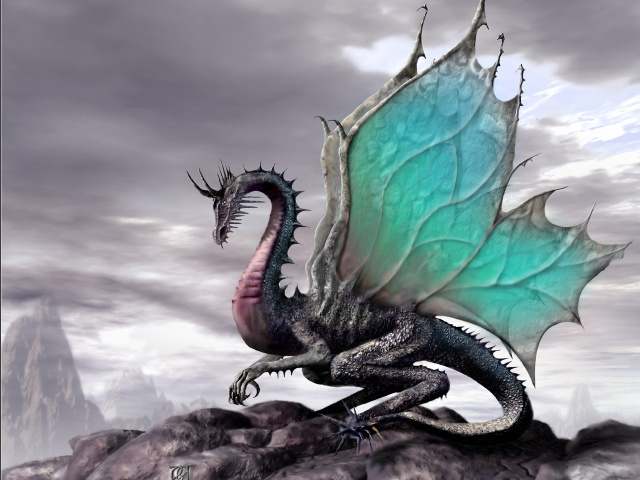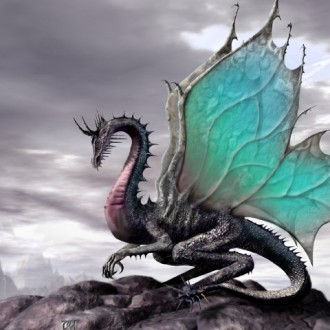


How to Draw a Dragon
Please PAUSE the video after each step to draw at your own pace.
For the first few steps, don’t press down too hard with your pencil. Use light, smooth strokes to begin (scroll down to see the final dragon drawing).
Step 1: Draw two circles as guides for the dragon’s body. They don’t have to be perfect. They’re just guides. Instead, pay attention to the size and spacing of the circles. That will determine the size of your dragon.
Step 2: Draw a smaller circle on the upper right side of the dragon’s body. The height of the circle will determine the dragon’s neck length, so place it accordingly.
Step 3: Draw an arc next to the head as a guide for the dragon’s muzzle.
Step 4: Draw angled lines below the dragon’s body as guides for the legs. If you want your dragon to have longer legs, draw longer lines. Make the squiggles darker in certain areas to create the stripey look.
Step 5: Draw a series of curved lines that connect the major shapes and form the dragon’s neck and the body.
Step 6: Draw a couple of lines that meet at a point on the left side as a guide for the dragon’s tail. You can draw the tail as long and curved as you’d like.
Step 7: Draw an angled line on top of the body as a guide for the dragon’s wings. That’s it for the initial sketch! From this point, press harder with your pencil to get a more defined sketch.
Step 8: Draw the dragon’s eye on the upper right side inside the circle. The shape of the eye is similar to a football. Shade the inside except for a small circle to represent glare. Draw a few lines surrounding the dragon’s eye for extra detail. Above the eye, draw a few jagged lines for a bony structure.
Step 9: Use the curved line on the right as a guide to draw the dragon’s muzzle. Draw the upper part of the mouth as a wavy line that extends back toward the circle and draw a small slit on top for the nostril. Use another wavy line underneath to draw the lower part of the dragon’s mouth. Draw tiny triangles inside the mouth to create the rows of sharp teeth. Use the bottom of the arc as a guide to draw the lower jaw. You can draw a small spike under the dragon’s chin for more detail.
Step 10: Draw a series of curved lines on top of the dragon’s head for horns. Draw lightly at first to get the structure right, then darken it. Make them longer or shorter, or draw more horns if you’d like.
Step 11: If you’d like, you can draw an ear below the dragon’s horns for more detail.
Step 12: Using the lines as guides, draw the dragon’s hind legs. Draw lightly at first to get the structure right. When you’re happy with what you have, go ahead and darken it. Draw a couple of toes at the bottom and a few lines on top to indicate folds of skin. Draw the visible portion of the dragon’s leg on the other side.
Step 13: Use the initial lines as guides to draw the dragon’s front legs. Remember to draw lightly at first and only darken once you get the structure right. You can draw the dragon’s leg on the other side raised or for a simpler version, draw it next to the other leg like the hind legs. If you draw the leg raised, draw the dragon’s toes as a series of angled lines pointing down.
Step 14: Use the initial angled line as a guide to draw the first part of the dragon’s wing. Thicken up the guide line, especially at the base. Draw a pointy spike on the top right angle of the wing as extra detail.
Step 15: For the second part of the dragon’s wing, draw a series of curved, pointy lines inside to give it more structure. Be sure to draw lightly at first to get the structure and spacing of the lines right.
Step 16: Now that you have the bony structure down, draw a few curved lines in between to get the attached skin that forms the dragon’s wing.
Step 17: Draw the wing on the other side by using the dragon’s wing in front as a guide.
Step 18: Draw the dragon’s neck and body using the initial shapes and lines as guides. Use small lines on the right side of the dragon’s neck to represent scales.
Step 19: Darken the shape of the dragon’s tail. If you’d like, you can draw an arrow-like point at the end for extra detail.
Step 20 (optional): You can stop here for a sketchy look or erase as much as you can of the initial guide lines for a cleaner look. Don’t worry about erasing all of them. It’s okay to leave some behind. Also re-draw any final sketch lines that you may have accidentally erased.
Step 21 (optional): Add as much detail as you want throughout your dragon drawing. You can draw spikes along the dragon’s back, scales in the body, veins in the wings or anything else you want.
Step 22 (optional): Add some shading to your dragon to give it more dimension and volume. Pick the direction of the light source when shading so that the shadows are consistent with it. Vary the pressure on your pencil to get different degrees of tonal value.
Step 23 (optional): Add a cast shadow underneath the dragon. This helps ground the dragon so it doesn’t appear to be floating.
Step 24 (optional): You can add more value throughout your dragon drawing for extra detail. To get this rough, scaly look, draw squiggly all over the body. Don’t overthink it. Just add them randomly. Dragons are mythical creatures, so be creative and draw your dragon any way you’d like! Your interpretation of a dragon may be different, so use the steps in this video as guidelines, not rules.



